October 2nd 2003
Sawanoya Ryokan, Tokyo
It's a little before 5:30 am here, and I'm tired but wide awake, thanks to jet lag. So far, Japan is good, although I haven't done that much.
So far, things have also been much as I expected. I have to duck to get into my hotel room if I don't want to bash my head on the lintel, there are vending machines all over the place, and Tokyo looks a lot like it does in the documentaries. The toilets in the ryokan have control panels. I'm sleeping on a futon on a tatami mat floor. There's a copy of the Teachings of the Buddha rather than a Bible in my room.
So, no culture shock yet, but it feels as though I am in Japan. I'm still doing quite well with speaking in Japanese to people. The main English conversation I had yesterday was when I phoned my friend Yuriko to confirm arrangements for meeting up tomorrow.
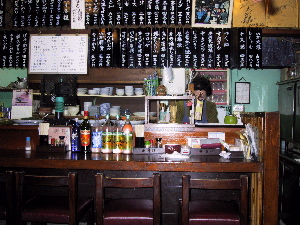 Tagosaku. The kitchen is behind the counter, and the hanging strips with Japanese writing on are the Japanese menu.
Tagosaku. The kitchen is behind the counter, and the hanging strips with Japanese writing on are the Japanese menu.
Last night I went to eat at a yakitoriya (fried chicken restaurant) recommended by the owner of the ryokan. It was good, and not very expensive -- 650 yen (about four pounds) for a nice set meal including fried chicken skewers, rice, miso soup, and some cold (deliberately) vegetables. I took a couple of photos while the camera was in a good mood, and spoke to the staff a bit. One of them complimented me on my Japanese, but I didn't understand that sentence. That seems to happen a lot, and I don't think it's coincidence. Once someone has decided to compliment me on my Japanese, I think they tend to stop making concessions to the foreginer. At that point, of course, I cease to be able to understand, because my Japanese isn't that good yet. At any rate, it's funny.
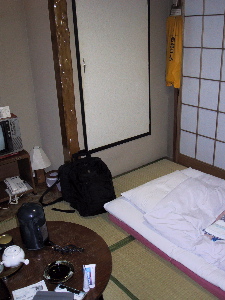 My room at Sawanoya Ryokan. Small, but comfortable.
My room at Sawanoya Ryokan. Small, but comfortable.
Thus far, the ryokan is very good. It's clean, the staff are extremely nice and helpful, and some of them speak English, and it seems to be in a good location. I was too tired to bathe last night, so I haven't tried the shower yet. On the downside, the rooms are very small, and the toilets and bathrooms are shared, although I believe a couple of the more expensive rooms have their own baths. Small rooms are standard for Tokyo, and given how inexpensive this place is, sharing toilets and bathrooms isn't a problem. They only serve breakfasts, which is why I went elsewhere for dinner, and I've not eaten that yet so I can't comment on that either.
Going back to the complicated toilet, it was a bit confusing. The English name is 'Shower Toilet', and I hope they'd change that before trying to market it in an English-speaking country. Anyway, it combines a toilet and bidet thing, and the control panel is for that. The advantage of being able to read Japanese is that I could inspect the buttons and determine that none of them flushed the toilet. The flush control is a handle on the side, with two kanji on it. They're the kanji for 'small' and 'large' -- it's dual flush, and you push the handle in different directions for the two options. So my Japanese study has already stood me in good stead.
In the dining room there's an internet-connected computer, so I can check and send email. I can't connect this machine to the internet, though, so these diary entries will have to wait to be uploaded. In addition, the apostrophe is on a different key on Japanese keyboards, because it isn't used so much, and that really threw my typing. I think I'll be writing short emails for the next couple of days.
My room has shoji, paper screens, across the windows, and the light of dawn is just starting to filter through them. I'm sitting on a cushion on the floor, looking at the tokonoma (alcove) as I type. I should probably write a haiku in honour of the situation.
Awake in Japan,
As dawn light shines through paper.
Birds sing in Tokyo.
There. Don't expecct me to do this repeatedly, though. (And I'm counting Tokyo as two syllables, so you have to pronounce it with an English accent. I am not going to try writing a Japanese haiku, thankyouverymuch.)
Evening
Well, who'da thunk it. Now that I'm actually in Japan, I have more things to put in the Japan diary. Of course, it helps that I've been determinedly sight-seeing today, and I've ticked a couple of must-see attractions off the list.
In the morning, I had a shower and a western-style breakfast. Apart from taking a long time to run hot, the shower was good, and the breakfast was fine. I'm having a Japanese-style breakfast tomorrow, so we'll see what that's like. The western-style breakfast is very nicely presented: the butter, marmalade, and jam come in an elegant wooden box, like a bento lunch.
After breakfast, feeling much more like a human being, I went to Ueno. This is within easy walking distance of the ryokan (easy for me: probably about a mile), and the route takes you through Shitamachi, which is a very interesting area of Tokyo, with lots of small shops. Indeed, a lot of Tokyo seems to have lots of small shops. As I walked through, it struck me that Tokyo is not really westernised. It looks nothing like a western city, although it doesn't look like the stereotyped image of a Japanese city, either. There are temples and shrines all over the place, but they aren't always obvious.
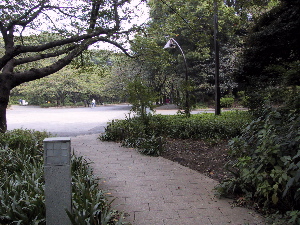 A view of Ueno park.
A view of Ueno park.
The first attraction at Ueno is the park, which is the largest public park in Tokyo. It's a nice park, with a lot of feral pigeons and, apparently, feral cats as well, although I didn't see them. There are also a number of homeless people sleeping there, although they seem to keep to themselves much more than the homeless in England. There is a large pool, which was invisible under vegetation, and there are several shrines, temples, and museums dotted throughout. There is also a zoo, which is famous for having two giant pandas, but I'm not really into zoos, so I didn't go.
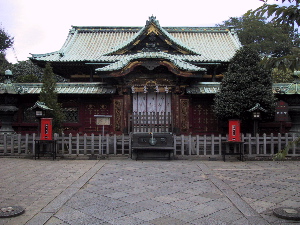 The entrance gate to the shrine compound at Toshogu Shrine, from outside the compound.
The entrance gate to the shrine compound at Toshogu Shrine, from outside the compound.
The most important shrine in the park is the Toushogu Shrine, which is dedicated to Ieyasu Tokugawa, the shogun who unified Japan after the civil wars of the sixteenth century and ushered in two and half centuries of peace. As a result, he is one of the most significant figures in Japanese history, probably the most significant in secular history. The shrine is also significant, as it was completed in the middle of the seventeenth century, and hasn't suffered any significant damage since, not in the bombings of the Second World War, and not during the Meiji Restoration. The latter is slightly more remarkable, because the big battle of that event was fought basically just outside it.
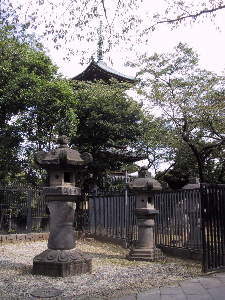 A picture to prove I'm really in Japan. Some stone lanterns with a five-storey pagoda visible through the trees behind. The lanterns and pagoda belong to Toshogu Shrine, but the pagoda is in the grounds of the zoo.
A picture to prove I'm really in Japan. Some stone lanterns with a five-storey pagoda visible through the trees behind. The lanterns and pagoda belong to Toshogu Shrine, but the pagoda is in the grounds of the zoo.
It's a superb building. I don't know how popular it is, as there is an admission charge (200 yen for an adult), but I arrived there quite soon after it opened and I had the shrine to myself, apart from the attendant. That was a really interesting experience. You are allowed to enter the shrine, but you must take your shoes off first. There are no photographs inside, and at first I thought that meant inside the shrine compound, so I went round without taking any. I think that was a good idea, because the calm of the place really struck me. When I came out, I asked the attendant whether it was alright to take photographs there, and he told me that I could take them inside the compound but outside the shrine as well, so I went back in and got snap-happy. The photos on this page were taken from outside the compound, though.
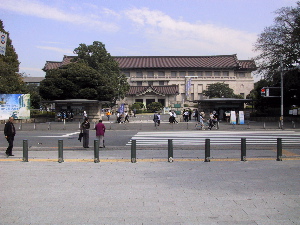 The Honkan, or Main Hall, of the Tokyo National Museum.
The Honkan, or Main Hall, of the Tokyo National Museum.
After the shrine, I went to the Tokyo National Museum, which has the best collection of Japanese art in the world. There are several buildings, but I only went into two: the Honkan (main building), which contains the main exhibition of Japanese art, and the Horyujikan, which contains treasures from Horyuji, a temple in Nara (I think) which donated some ancient (seventh or eighth century) Buddhist artefacts to the Emperor in the nineteenth century.
The museum displays were great, and I would like to go back at some point. In fact, when my family visit, I'll have to go back, so it's a good job I want to. There are some particularly spectacular Heian wood carvings, and a number of Kannon statues. It's really difficult to describe the contents; there's just so much. I did both buildings in a couple of hours. (I also spent 525 yen on a glass of Coke. I really needed a drink, and that was cheaper than leaving the museum, buying a Coke, and coming back. By about 30 yen. Leaving would have been a lot more effort, though.) By the end, I was rather overwhelmed.
Then, as I was walking across the park to find some lunch, a random Japanese guy stopped me to practice his English. Yes, as a foreigner you do stand out in Tokyo. It was an interesting, if slightly surreal experience.
Anyway, I wandered around Ueno a bit looking for somewhere cheap to eat. I passed a number of interesting establishments, strip clubs and hostess bars and the like, all mixed in with perfectly standard restaurants, art galleries, and shops. I finally ate in a random sushi bar, which was OK, but I don't think I'll try to hunt it down again. Lunch was 600 yen, so slightly more expensive than the Coke.
After lunch, I walked back to the ryokan to dump my photographs onto the computer, recharge the camera battery a bit, and decide where to go next. I decided to go to Meiji-jinguu (the Meiji shrine), and on the way out I bought a half litre bottle of Coke for 140 yen. Much more reasonable. Still pricey by English or American standards, though.
I got to the Meiji shrine by underground. There didn't seem to be many English signs in the station, or English instructions on the automatic ticket machines, so it's a good job I can read Japanese. I travelled out at about half past three, so the train was very quiet.
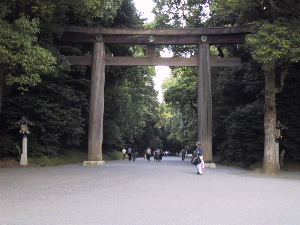 The massive cypress torii at the entrance to Meiji-jinguu.
The massive cypress torii at the entrance to Meiji-jinguu.
The Meiji-jinguu enshrines the Meiji Emperor and his Empress, who are both Shinto deities. It's a popular shrine, and I certainly didn't have this one to myself. It's set in a large park, although the public are not allowed to wander around most of it. The path to the shrine starts at an enormous cypress torii, one of the largest two in Japan (the other largest is halfway down the path), and it's a walk of several minutes to get to the shrine. It is a nice walk, even with the hordes of Japanese tourists. I saw quite a few other foreigners, as well.
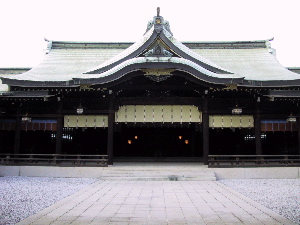 The main hall at the Meiji-jinguu. ("jinguu" means "shrine", so it's not the Meiji jinguu shrine.)
The main hall at the Meiji-jinguu. ("jinguu" means "shrine", so it's not the Meiji jinguu shrine.)
The shrine itself is large, and has lots of shops selling charms and votive tablets. These operations are as formalised as the gift shops at any English cathedral, except that they are actually selling the blessings of the resident deities. Shinto has always been more pragmatic than Christianity, so this is an ancient tradition rather than an intrusion of commercialism. It also seems to suit the Japanese attitude to religion perfectly. I bought myself a charm for scholarship in the shape of a miniature shrine; it's quite pretty.
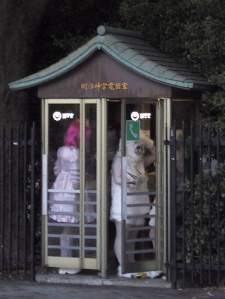 Some Japanese people in a phone booth. No, they weren't all dressed like this.
Some Japanese people in a phone booth. No, they weren't all dressed like this.
After leaving the shrine, I wandered down Takeshita doori in Harajuku, one of the main shopping centres for Japanese teenagers. It was full of people, many of whom had probably just got out of school, as they were still in uniform. Many of the shops had English names, like Store Your Ducks and Nudy Boy, to take the two funniest at random. I don't think that's a bit of Japan that I'll be hurrying back to, but it was certainly an interesting experience.
I got the subway back to Nezu station, and by now it was about half past five, so it was rather more crowded. I don't think I was the only foreigner in the car, but there was only one other even when it was packed. It's slightly strange being in such a homogeneous society. On the way back I stopped at Takosagu again for dinner, since it was good last night and not too expensive. Then I came back, checked my email, and wrote this diary up. Now, I think I will go to bed.